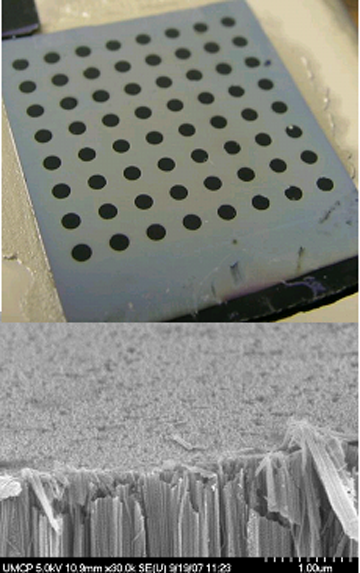![]() Laser Desorption/Ionization Mass Spectrometry for Trace Explosives Detection
Laser Desorption/Ionization Mass Spectrometry for Trace Explosives Detection
PI: Prof. Don DeVoe
A novel matrix-free laser desorption/ionization mass spectrometry (LDI-MS) platform has been developed based on nanofilament silicon (nSi) substrates. The technology overcomes key limitations of existing LDI-MS systems for trace explosives detection by enabling increased surface/analyte binding, improved contaminant removal, enhanced ionization at low laser powers for higher sensitivity detection, and on-target sample concentration. While optimization of the technology is ongoing, proof-of-concept has been demonstrated with detection of nitroaromatic and nitramine-based energetic materials well below the current limit of other emerging platforms such as desorption/ionization (DESI).
While our initial efforts have primarily been focused on demonstrating the nanofilament silicon fabrication process and leveraging a proprietary electrowetting methodology to achieve efficient adsorption of purified sample on the nSi surfaces, commercial application of the technology will require compatibility with “dirty” samples acquired from a variety of sources. Preparing the sample for nSi-MS demands the removal of particulates and fractionation to isolate the target molecules to the greatest degree possible without sacrificing detection sensitivity. To this end, we are developing a disposable microfluidic sample collection cartridge, combining multi-stage filtration of particulate matter, solid-phase extraction of low molecular weight species on the basis of both differential hydrophobicity and ion exchange properties, buffer exchange to bring the sample to the optimal pH for nSi-MS sensitivity optimization, and final deposition onto an integrated nSi chip within the microfluidic system. The cartridge will only require a user to add a sample volume in dry or solvated form to a loading reservoir, followed by manual pressure actuation of on-chip buffers and solvents to drive the sample preparation and deposition process. The result will be a sample loaded onto the nSi substrate ready for LDI-MS analysis. The combination of the nanofilament silicon and microfluidic sample preparation is expected to position the resulting technology at the forefront of presently-available commercial trace explosives detection platforms.

Nanofilament silicon array chip (top) and electron micrograph of the nanofilament surface (bottom)

